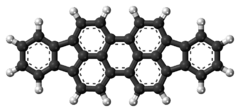Diindenoperylene
 | |
 | |
| Names | |
|---|---|
| IUPAC name
Diindeno[1,2,3-cd:1',2',3'-lm]perylene | |
| Other names
Periflanthen; Periflanthene | |
| Identifiers | |
| 188-94-3 | |
| 3D model (Jmol) | Interactive image |
| Abbreviations | DIP |
| ChemSpider | 87318 |
| ECHA InfoCard | 100.005.343 |
| PubChem | 96712 |
| |
| |
| Properties | |
| C32H16 | |
| Molar mass | 400.48 g·mol−1 |
| Appearance | Orange solid |
| Boiling point | >330 °C (sublimation) |
| Except where otherwise noted, data are given for materials in their standard state (at 25 °C [77 °F], 100 kPa). | |
| | |
| Infobox references | |
Diindenoperylene (DIP) is an organic semiconductor which receives attention because of its potential application in optoelectronics (solar cells, OLEDs) and electronics (RFID tags). DIP is a planar perylene derivative with two indeno-groups attached to opposite sides of the perylene core. Its chemical formula is C32H16, the full chemical name is diindeno[1,2,3-cd:1',2',3'-lm]perylene. Its chemical synthesis has been described.[1][2]
The molecular weight is 400.48 g/mol, the dimensions of the molecule in its plane are ~18.4×7 Å.[3] and its sublimation temperature is above 330 °C.[4] It is non-polar and therefore only slightly soluble, for example in acetone.
DIP is a red dye[5] and has been used as active material for optical recording.[6] Because of its ‘perylene-type’ optical emission in the visible spectrum, it has also been used in organic light emitting diodes.[7] Organic field effect transistors of DIP have been studied.[8] The charge carrier mobility achieved was up to 0.1 cm²/(V·s) for thin film transistors with silicon dioxide as gate dielectric, making DIP a good candidate for further optimisation.[9]
The structure of bulk DIP crystals has recently been studied by Pflaum et al., who found two distinct phases at room temperature and at temperatures above 160 °C. In thin films for growth ‘near equilibrium’ (at substrate temperature of about 130 °C) by organic molecular beam deposition (OMBD), DIP has been shown to order very well.[2][10] The structure of thin DIP films has been characterized ‘post-growth’,[2][11][12][13] with structures differing from the room-temperature bulk structure. These thin-film structures depend on the substrate used, and also on the substrate temperature during growth.[10]
References
- ↑ J. von Braun, G. Manz, in Deutsches Reichspatentamt, Berlin. (Germany, 1934).
- 1 2 3 E. Clar, Polycyclic hydrocarbons (Academic Press, London, New York, 1964), p. 2
- ↑ Dürr, A. C.; Schreiber, F.; Münch, M.; Karl, N.; Krause, B.; Kruppa, V.; Dosch, H. (2002). "High structural order in thin films of the organic semiconductor diindenoperylene". Applied Physics Letters. 81 (12): 2276. Bibcode:2002ApPhL..81.2276D. doi:10.1063/1.1508436.
- ↑ A. C. Dürr, Ph.D. thesis, Universität Stuttgart (2002)
- ↑ Heilig, M; Domhan, M; Port, H (2004). "Optical properties and morphology of thin diindenoperylene films". Journal of Luminescence. 110 (4): 290. Bibcode:2004JLum..110..290H. doi:10.1016/j.jlumin.2004.08.023.
- ↑ H. E. Simmons. (1987)
- ↑ H. Antoniadis, A. J. Bard. (Hewlett-Packard Company & The Board of Regents of The University of Palo Alto, CA, 1997)
- ↑ M. Münch, Ph.D. thesis, Universität Stuttgart (2001)
- ↑ N. Karl, in Organic Electronic Materials R. Farchioni, G. Grosso, Eds. (Springer, Berlin, 2001), vol. II, ISBN 3-540-66721-0 pp. 283 ff.
- 1 2 Kowarik, S.; Gerlach, A.; Sellner, S.; Schreiber, F.; Cavalcanti, L.; Konovalov, O. (2006). "Real-Time Observation of Structural and Orientational Transitions during Growth of Organic Thin Films". Physical Review Letters. 96 (12): 125504. Bibcode:2006PhRvL..96l5504K. doi:10.1103/PhysRevLett.96.125504. PMID 16605925.
- ↑ Dürr, A.; Schreiber, F.; Ritley, K.; Kruppa, V.; Krug, J.; Dosch, H.; Struth, B. (2003). "Rapid Roughening in Thin Film Growth of an Organic Semiconductor (Diindenoperylene)". Physical Review Letters. 90 (1): 016104. Bibcode:2003PhRvL..90a6104D. doi:10.1103/PhysRevLett.90.016104. PMID 12570630.
- ↑ Dürr, A.; Koch, N.; Kelsch, M.; Rühm, A.; Ghijsen, J.; Johnson, R.; Pireaux, J.-J.; Schwartz, J.; Schreiber, F.; et al. (2003). "Interplay between morphology, structure, and electronic properties at diindenoperylene-gold interfaces". Physical Review B. 68 (11): 115428. Bibcode:2003PhRvB..68k5428D. doi:10.1103/PhysRevB.68.115428.
- ↑ Hoshino, A; Isoda, Seiji; Kobayashi, Takashi (1991). "Epitaxial growth of organic crystals on organic substrates — polynuclear aromatic hydrocarbons". Journal of Crystal Growth. 115: 826. Bibcode:1991JCrGr.115..826H. doi:10.1016/0022-0248(91)90854-X.